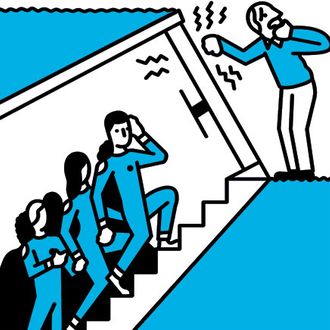
With Rocket Man and the Dotard lobbing threats over the Pacific, prepping for hellfire has become that rarest of American phenomena in 2017: a unifying activity. “During Obama, you had people worried about civil unrest,” says Gary Lynch over the phone from Texas, where he manages Rising S Bunkers, which will install a steel shelter beneath your backyard — starting price: $39,500. “Now people are worried that Trump won’t back down if someone pushes him into a war.”
But for those wanting membership in an underground community bunker built by Vivos Group — say, one of the 575 converted bomb-storage bunkers in South Dakota, or a shared, luxe, 80-person Cold War–era bunker in Indiana that will sustain life inside for at least a year — money isn’t enough. You must convince a selection committee that you’re a worthy entrant to the end-of-days Noah’s Ark.
Even doomsday prep has its velvet rope, but Vivos generously let us inside to take a look at the applications.
One applicant was a 30-something from San Jose, California, who filled out Vivos’s online application, clicking the skills boxes for “programmer,” “scientist,” “engineer,” and “executive.” He said he was a dual U.S.-E.U. citizen and father of a 3-year-old. He then soldiered on to the essay portion, linking to his patents and emphasizing (twice) his computer-science Ph.D. “I am highly confident we architect, design, implement and rebuild everything that is needed in the new era,” he wrote. Typed in “Always good to plan for the worst.” Clicked “yes” to the question “Do you believe that the world faces near-future catastrophes?” And, when asked just which disaster he most feared, replied, “A possible new War within years.”
Another applicant is Justin, a 30-something “technology-savvy young professional” from San Ramon, California (“engineer,” “executive,” “martial artist,” “survivalist”). He admitted to becoming beset by dark fears about any number of catastrophes. He’d already been stockpiling food, water, and alternate power. “I feel the world at some point will no longer be able to support the ever-growing expansion of the human race, oxygen levels will begin to deplete, chaos would erupt … being prepared will mean the difference between those who survive” — of whom he hoped to be a part — “and the billions that unfortunately will not.” Justin wanted room for two adults and a child in the bunker and bragged he could “plan, execute, and communicate projectlike work on nearly any aspect of life.” His martial arts — karate, judo, jiu-jitsu, Krav Maga — would act as “security should firearms fail, become compromised, or depleted,” he wrote. He had just one technical question: “How will oxygen be created and CO2 cleaned without sunlight?”
Vivos employees vet the applications and call the contestants, weeding out people with psychological problems, prior convictions, or intolerance of diversity, given life will be cozy down there and no one wants to have to use the detention area. They aim for a gender balance — lest the bunker become
a subterranean sausage fest — and an array of skills. “They’re not all doctors or scientists or Wall Street or military guys,” says Vivos CEO Robert Vicino. “You have plumbers and mechanics … all walks of life.” Both the Ph.D. and Justin made the cut. Additionally, Vicino interviewed an oil mogul from Texas who said he couldn’t sleep he was so worried. He nabbed space in the Indiana bunker for four generations of his family and now snoozes, Vicino reports, “like a baby.”
*This article appears in the October 2, 2017, issue of New York Magazine.





























